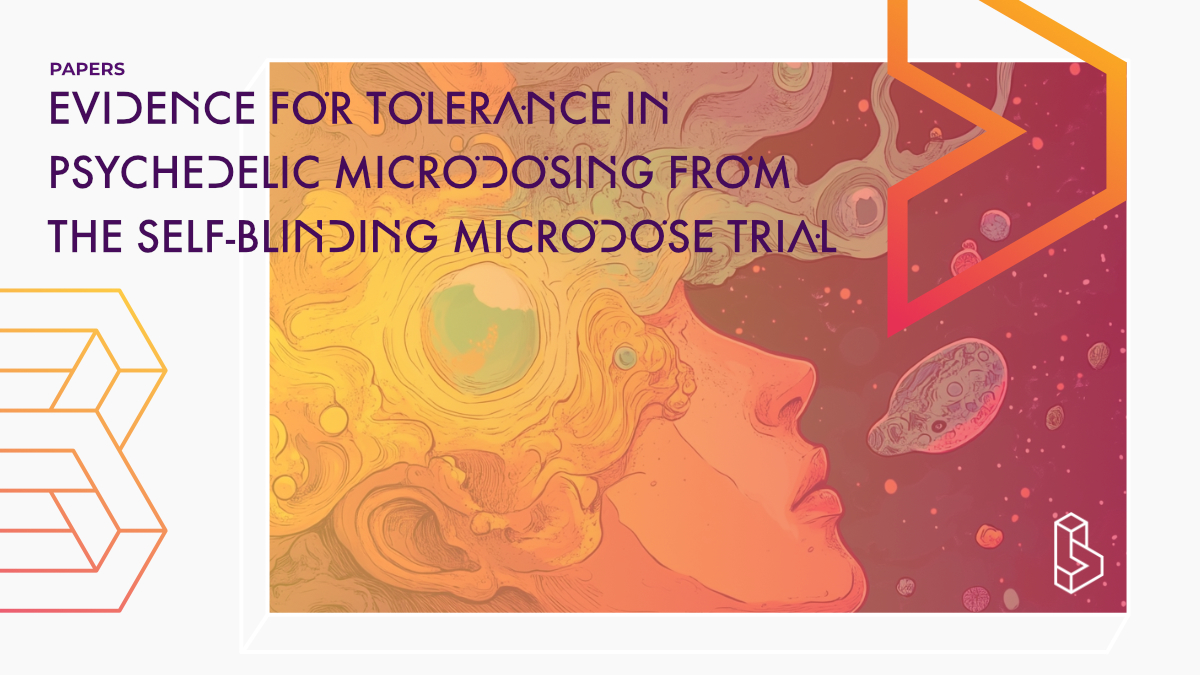This pre-print reanalysed data from a placebo-controlled citizen science microdosing study (n=240) to investigate whether tolerance develops during microdosing. It was conceptualized that if tolerance develops, the probability of correctly guessing active microdoses should decrease with more microdoses. Linear regression models showed that correct microdose guess probability decreased with the number of microdoses taken (p=0.09) indicating that tolerance developed.
Abstract of Evidence for tolerance in psychedelic microdosing from the self-blinding microdose trial
“Microdosing is the practice of regularly using very low doses of psychedelic drugs. Anecdotal reports suggest that it may enhance well-being, creativity and cognition. Here, we use data from a self-blinding microdose trial, a large (n=240) placebo-controlled citizen science trial of microdosing to investigate whether tolerance develops during microdosing. We conceptualized tolerance as the relationship between correct microdose guess probability and the number of previous microdoses taken within the trial’s timeframe: if tolerance develops then, correct microdose guess probability should decrease with more microdoses taken. Mixed linear regression models show that correct microdose guess probability decreases with number of microdoses taken (mean±se: -.017±.007; p=.009), suggesting that tolerance developed. Secondary post-hoc analysis revealed that this tolerance was present with LSD/LSD-analogue microdoses (mean±se: -.026±.007; p<.001), but not with psilocybin microdoses (mean±se: .013±.014; p=.36). These results suggest that microdosers may need to periodically suspend their microdosing routine to avoid tolerance and that psilocybin may be better suited for long-term microdosing protocols.”
Authors: Stefan Baumann, Robin L. Carhart-Harris, David J. Nutt, David Erritzoe & Balázs Szigeti
Summary of Evidence for tolerance in psychedelic microdosing from the self-blinding microdose trial
Microdosing, the practice of regularly using very low doses of psychedelic drugs, may enhance well-being, creativity and cognition. However, a study suggests that tolerance may develop during microdosing and that psilocybin may be better suited for long-term microdosing protocols.
Psychedelic compounds have been used in therapy for over a decade to help individuals suffering from mental illness.
Find this paper
Evidence for tolerance in psychedelic microdosing from the self-blinding microdose trial
https://doi.org/10.31234/osf.io/s4qhf
Open Access | Google Scholar | Backup | 🕊
Cite this paper (APA)
Baumann, S., Carhart-Harris, R., Nutt, D., Erritzoe, D., & Szigeti, B. (2022). Evidence for tolerance in psychedelic microdosing from the self-blinding microdose trial.
Study details
Compounds studied
Psilocybin
Placebo
Topics studied
Microdosing
Study characteristics
Placebo-Controlled
Single-Blind
Randomized
Re-analysis
Participants
240
Humans
Authors
Authors associated with this publication with profiles on Blossom
Robin Carhart-HarrisDr. Robin Carhart-Harris is the Founding Director of the Neuroscape Psychedelics Division at UCSF. Previously he led the Psychedelic group at Imperial College London.
David Nutt
David John Nutt is a great advocate for looking at drugs and their harm objectively and scientifically. This got him dismissed as ACMD (Advisory Council on the Misuse of Drugs) chairman.
David Erritzoe
David Erritzoe is the clinical director of the Centre for Psychedelic Research at Imperial College London. His work focuses on brain imaging (PET/(f)MRI).
Vestaen Balbuena
Vestaen Balbuena is co-founder and Chief of Staff at Aphrodite Health. Vestaen is a multifaceted entrepreneur and intrapreneur, focused on incubating and scaling startups in the health, technology and consumer goods industries.
Institutes
Institutes associated with this publication
Imperial College LondonThe Centre for Psychedelic Research studies the action (in the brain) and clinical use of psychedelics, with a focus on depression.
Compound Details
The psychedelics given at which dose and how many times
LSD 5 μg | 4x Psilocybin 0.12 g | 4xLinked Research Papers
Notable research papers that build on or are influenced by this paper
The difference between ‘placebo group’ and ‘placebo control’: a case study in psychedelic microdosingThis computational analysis (2023) employs computational modelling to illustrate how weak blinding and positive treatment expectancy can cause an uneven distribution of expectancy effects, termed 'activated expectancy bias' (AEB). The study introduces the Correct Guess Rate Curve (CGRC), a tool to estimate the results of a perfectly blinded trial using data from an imperfect one, and re-analyzed the ‘self-blinding psychedelic microdose trial’ dataset (n=191) to demonstrate that placebo-microdose differences may be susceptible to AEB, thereby suggesting microdosing can be viewed as an active placebo.
Self-blinding citizen science to explore psychedelic microdosing
This self-blinding experiment (n=191) finds that the placebo and microdosing groups both experienced similar improvements in self-rated psychological well-being and cognitive function (e.g. mood, energy, creativity) after four weeks. This study provides more evidence that microdosing benefits can be attributed to expectancy (placebo) effects.

